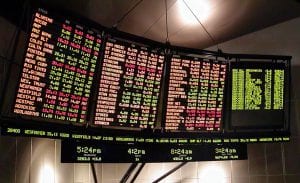
Bond Market Crash: Unveiling Hidden Opportunities Amidst Chaos
The financial markets are a complex dance of supply and demand, risk and reward, fear and greed. They have an uncanny knack for both reflecting and shaping human behaviour. One of the most intriguing phenomena in these markets is the bond market crash. But what exactly does the term “Bond Market Crash” entail?
Grappling with the “Bond Market Crash”: A Definitional Dilemma
As ominous as it sounds, a bond market crash is a fascinating economic phenomenon that merits our understanding. At its rudimentary core, this crash transpires when bond prices nosedive drastically, catalyzing a steep ascent in yields. This shift is often precipitated by a collective loss of investor confidence in the economic landscape, triggering a mass exodus or sell-off of bonds.
This event, replete with turmoil and uncertainty, could be likened to a fierce storm, unsettling the tranquil waters of the financial markets. But, as with any storm, it’s not just about the disruption; it’s also about the aftermath and the potential for regeneration.
A bond market crash is not merely a harbinger of fiscal doom. Instead, it’s a complex puzzle, a definitional dilemma that challenges traditional financial wisdom. It demands investors to recalibrate their strategies, adapt to the changing market dynamics, and navigate the unfamiliar terrain with discernment and foresight.
Contrary to popular belief, these crashes do not signal the end of the financial world. Instead, they expose the vulnerabilities and inefficiencies within the system, compelling economic stakeholders to introspect and innovate. In this sense, a bond market crash can be viewed as a catalyst for change, a wake-up call that stirs the status quo.
Moreover, these crashes can unveil hidden treasures for the keen-eyed and resilient investor. The sudden price drop could present undervalued bonds, ripe for the picking. Hence, amidst the apparent chaos, opportunities abound for those daring enough to delve beneath the surface of this definitional dilemma.
Grappling with a bond market crash is a dual-edged sword. It poses significant challenges yet also unravels possibilities for growth and profit. It underscores the inherent dynamism of the financial markets, where risk and reward are two sides of the same coin.
The Dance of Interest Rates and Stocks: A Symbiotic Relationship
One must first decipher the intricate ballet between interest rates and stocks to seize the opportunities originating from economic upheavals such as a bond market crash. This dance, while complex, forms the backbone of our financial system, orchestrating a symbiotic relationship that impacts every investor’s portfolio.
At its essence, this relationship is a delicate balancing act. When interest rates ascend, borrowing costs swell, translating to increased expenses for companies looking to finance their operations or embark on new ventures. This cost surge can gnaw away at their profits, which can subsequently trigger a tumble in stock prices.
Envision this scenario like a seesaw. As one side (interest rates) elevates, the other (stock prices) descends. While seemingly adverse, this dynamic is a necessary part of the economic ecosystem, ensuring that growth is sustainable and controlled.
However, this dance is not a one-way street. The opposite is equally plausible. As interest rates swoop down, it becomes less costly for companies to borrow. This reduction in borrowing costs can stimulate business investments and expansion, bolstering profits. Consequently, stock prices can experience a boost, creating a potential gold rush for investors.
Picture this as a tide that ebbs and flows. When the tide recedes (interest rates fall), it reveals hidden treasures (rising stock prices). This oscillation makes the dance between interest rates and stocks so intriguing.
The symbiotic relationship between interest rates and stocks is a compelling dynamic, an economic dance that influences investment strategies, shapes financial decisions, and, ultimately, determines the rhythm of the markets. Understanding this dance is crucial for any investor seeking to navigate the financial seas successfully.
Historical Echos: From Tulip Mania to Modern Crashes
With its rich tapestry, history offers us valuable lessons about the opportunities birthed in the wake of bond market crashes. We find these lessons in various epochs, from the Tulip Mania that gripped the 1600s to the seismic 2008 Financial Crisis. These periods, marked by intense pessimism and economic turmoil, were often succeeded by market recovery and robust growth phases, painting a picture of resilience and renewal.
Let’s travel back to the 1630s, to the heart of the Tulip Mania. This period was characterized by a fevered rush to acquire tulip bulbs, a commodity that bloomed into an unlikely symbol of wealth and status. But when the bubble inevitably burst, the fallout was catastrophic. Individuals who had purchased tulip bulbs on credit found themselves saddled with worthless bulbs and crippling debts, plummeting them into a financial abyss.
However, this crisis was not a universal calamity. Those who had wisely conserved their cash, standing on the sidelines as the mania unfolded, found themselves in an advantageous position. As asset prices plummeted to rock-bottom levels, they seized the opportunity, buying up assets at bargain-basement prices. This prudent strategy laid the foundation for substantial gains when the market eventually rebounded, turning the crisis into an opportunity.
Hence, historical events like the Tulip Mania serve as poignant reminders of the potential opportunities that lurk within financial crashes. They emphasize the importance of financial prudence and strategic patience, qualities that can transform a crisis into a springboard for growth. In the echoes of these historical events, we find the blueprint for navigating modern crashes, underscoring the timeless relevance of these lessons.
Lemming Theory and Contrarian Investing: Swimming Against the Current
The investment world is much like a river, with investors as swimmers. Some prefer to float with the current, while others swim against it. The lemming theory and contrarian investing epitomize these contrasting approaches, offering unique perspectives on navigating the financial waters.
Drawing from the principles of mass psychology and collective behaviour, the Lemming theory encapsulates a common tendency among investors. Like lemmings, a small rodent species known for their alleged mass migrations, investors often follow the crowd, moving in the direction of the majority. However, this herd mentality can lead them astray, driving them towards unfavourable outcomes.
Contrarian investing, conversely, is the antithesis of the lemming theory. Much like swimmers fighting the current, contrarian investors deliberately veer away from the crowd. They buy when the market is awash with sellers and sell when it is teeming with buyers. This strategy, while contrarian by nature, can be remarkably effective.
In the throes of a bond market crash, contrarian investing shines as a beacon of opportunity. As bonds become oversold and prices plummet, contrarian investors see a golden chance. They buy up bonds at deflated prices, and effectively position themselves for potential gains when the market regains its footing.
The lemming theory and contrarian investing underscore the importance of independent thinking in investment decisions. They teach us that sometimes, swimming against the current, rather than drifting along with it, can lead to the most rewarding destinations.
The Chess Player’s Perspective: Calculating Moves Ahead
Much like a riveting game of chess, investing demands a blend of strategy, foresight, and an understanding of the playing field. Like grandmasters on a chessboard, successful investors must anticipate the market’s manoeuvres, deciphering its complex interplay and seizing the opportunities that emerge.
Each piece plays a pivotal role on a chessboard, from the humble pawn to the mighty queen. Every move, every strategy, carries weight and significantly influences the game’s trajectory. It’s a dance of decisions and consequences, where a single miscalculation can swing the balance of power.
Likewise, each asset class performs its unique dance in the financial markets, contributing to the market’s overarching rhythm. Bonds, stocks, commodities, and currencies – each has its part to play, and the actions of one can send ripples across the others. This intricate web of interdependency forms the core of the financial markets, with the movements of each asset class impacting the overall market dynamics.
For the astute investor, recognizing these interdependencies is akin to understanding the strengths and weaknesses of each chess piece. It offers a strategic edge, enabling them to anticipate market trends, identify potential opportunities, and make informed decisions.
In an oversold bond market, this chess player’s perspective empowers investors to capitalize on the situation. They can strategize their moves, buying up undervalued bonds and positioning themselves for potential gains when the market rebounds.
Viewing investing through the lens of a chess game underscores the importance of strategy and foresight. Much like a grandmaster calculates moves ahead, successful investors must stay ahead of the market, leveraging their understanding of the market’s interplay to their advantage.
Conclusion: Opportunity Amidst Chaos
In conclusion, while often seen as a sign of economic turmoil, a bond market crash can also present unique investment opportunities. Investors can turn chaos into opportunity by understanding the relationship between interest rates and stocks, recognizing the signs of an oversold market, and adopting a contrarian investment approach.
In the financial markets, as in life, the challenges often present the most significant opportunities. The next time you hear the phrase “Bond Market Crash,” remember that it may not be a call for panic but for calculated action.
Intellectual Delights: Engage Your Mind
Fed Interest Rate: Negative Rates Are A Game Changer
What Economic Recovery? Most Americans Lack $1000 In Savings
Federal Reserve Interest Rate: Dangers & Benefits of Negative Rates

Why Are Interest Rates So Low: Coronavirus That’s Why
CAT Stock Price Projections And Future Trends
Why own gold in uncertain times: Protection From Disaster
HD stock quote And future price trends
Valeant Shares Slump



